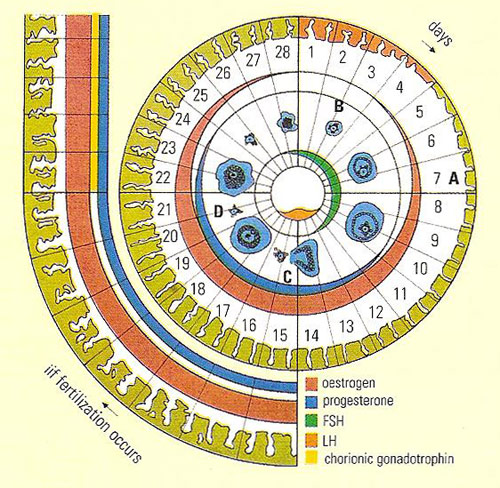menstrual cycle

The changes occurring during the menstrual cycle are controlled by the balance of the follicle stimulating hormone (FSH) and luteinizing hormone (LH) secreted by the pituitary. The diagram shows the changing levels of these, and of estrogen and progesterone induction from the ovarian follicle, together with changes in the structure of the uterine wall (A) and development of the follicle (B), in a circular form through a normal 28-day cycle. The sharp increase in LH at about mid-cycle causes ovulation (C) and, fertilization does not occur, the corpus luteum (D) formed degenerates around day 26 as pituitary hormone levels fall. The consequent withdrawal of estrogen and progesterone causes the uterine wall to shed itself in the menstrual flow. This then proliferates again under the influence of estrogen from a new follicle. If fertilization and egg implantation do occur the placenta produces chorionic gonadotrophin, possibly as early as day 21, that allows the corpus luteum to continue to produce estrogen and progesterone until the placenta takes over.
The menstrual cycle is a cycle in female humans and some higher primates of reproductive age, during which the body is prepared for pregnancy. In women, the average cycle is 28 days. At the beginning of the cycle, hormones from the pituitary gland stimulate the growth of an ovum (egg cell) contained in a follicle in one of the two ovaries. At approximately mid-cycle, the follicle bursts, the egg is released (ovulation) and travels down the fallopian tube to the uterus. The follicle (now called the corpus luteum) secretes two hormones, progesterone and estrogen, during this secretory phase of the cycle, and the endometrium thickens, ready to receive the fertilized egg. Should fertilization (conception) not occur, the corpus luteum degenerates, hormone secretion ceases, the endometrium breaks down, and menstruation occurs; the unfertilized egg is discharged in the blood flow from the vagina.
In the event of conception, the corpus luteum remains and maintains the endometrium with hormones until the placenta is formed. Menstruation, therefore, marks the end of the cycle. It is customary, for the purposes of contraception and calculating the date of an expected birth, to count the first day of bleeding as the first day of the next menstrual cycle. The onset of the menstrual cycle (menarche) is called puberty (age 10–15 years); it ceases with the menopause (around 50 years).


